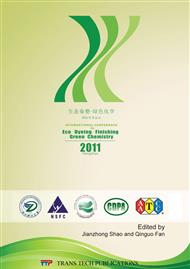p.403
p.408
p.413
p.421
p.426
p.431
p.436
p.442
p.447
Preparation and Application of Modified Nano-Titanium Dioxide Agent
Abstract:
Cotton is the most widely used fiber. However, cotton fabric has a relatively high UV radiation permeability. Compared with some synthetic fabrics, cotton fabrics anti-UV ability is lower. nanotitanium dioxide has a good catalytic and ultraviolet light shielding effect, so it can be used as anti UV finishing agent. Using modified nanotitanium dioxide to finish the cotton fabrics, one can get the function of anti-UV performance. Therefore, in this paper, nanotitanium dioxide was first modified with 1,6-hexamethylene diisocyanate and polyethylene glycol in order to improve their size stability. And then by way of finishing, the modified nanotitanium dioxide dispersion was soaked into cotton fiber. During a baking process, modified nanotitanium dioxide was combined with cotton fibers via covalent bonds.
Info:
Periodical:
Pages:
426-430
Citation:
Online since:
January 2012
Authors:
Price:
Сopyright:
© 2012 Trans Tech Publications Ltd. All Rights Reserved
Share:
Citation:


